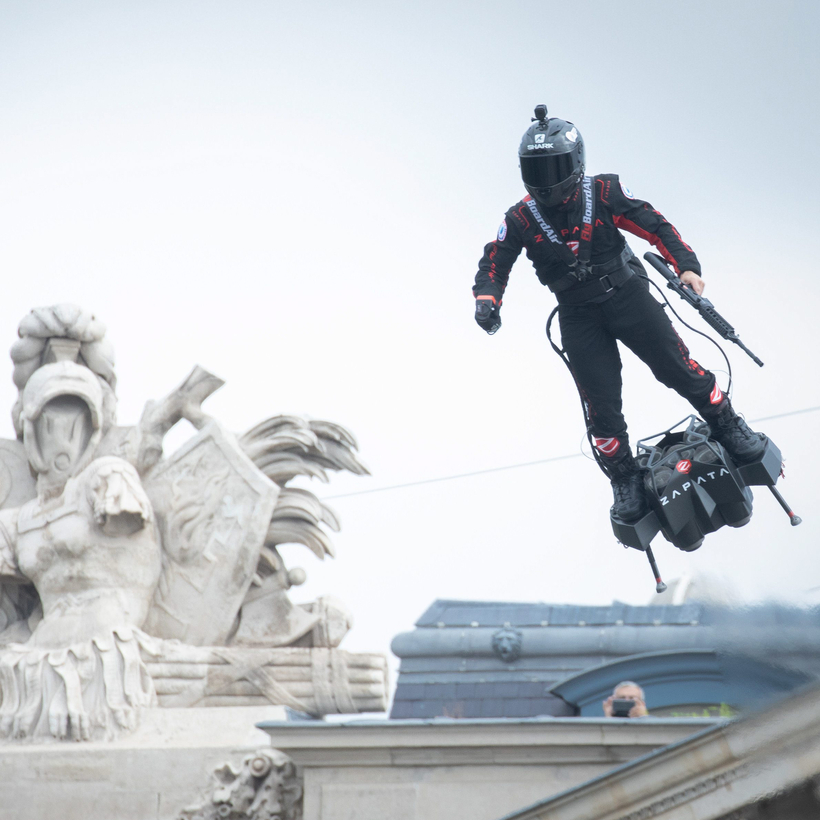The French are used to tanks, jeeps, and military forces rolling down the Avenue de Champs-Élysées every July 14. Even the infamous bearded fighters of the French Foreign Legion are no big deal.
But on this Bastille Day even the most jaded spectators stared incredulously as Franky Zapata, the inventor of the Flyboard, zigged and zagged high above the Place de la Concorde, surfing the air to prove to everyone watching the Bastille Day parade that the future of personal flight was now upon us.
What made Zapata’s spectacle even more impressive was the rifle he held in his right hand, which he surely reassured the public (and the security details of French president Emmanuel Macron and his guest, German chancellor Angela Merkel) wasn’t loaded. And by the time he’d safely landed, no one missed the Flyboard’s immense potential, either as an assault vehicle or as a solo craft for the risk-taker who has everything.

Zapata used that Iron Man moment to announce his next challenge: crossing the English Channel. And 11 days later, on the 110th anniversary of Louis Blériot’s maiden flight (by plane) across that 20-mile strait, Zapata took off from a stretch of beach at Sangatte near Calais and zoomed high above the water toward England.
In today’s world, where invention is most associated with Silicon Valley nerds pushing algorithms and apps, Zapata seems more like a modern-day Wright brother. Zapata, 40, is a former Jet Ski champion who’s been designing and testing the Flyboard and its various prototypes ever since he left the pro circuit in 2010.
In 2011, Zapata started by launching a water-propelled version, which allowed the hoverboard to climb close to 50 feet while linked to a watercraft by a long elastic tube. This model sold thousands and helped Zapata lock up sponsors like Breitling and Red Bull. He also appeared on the television show France’s Got Talent.
Zapata also appeared on the television show France’s Got Talent.
In 2016, Zapata scrapped the hose altogether, opting instead for a kerosene-fueled backpack (oui, a backpack filled with gas) to power the hoverboard’s five gas-powered turbines. According to Zapata Racing (Zapata’s company, which owns the patent), the Flyboard Air can now reach an altitude of nearly 500 feet and a speed of up to 87 miles per hour. Zapata showcased his invention off the coast of Sausset-les-Pins in the South of France that same year and quickly entered The Guinness World Records for the farthest flight achieved on a hoverboard.
Following a demonstration, Zapata Racing received a grant of around $1.5 million in December 2018.
For the moment, the Flyboard is not for sale and Zapata is the only one to attempt to ride it. Navigating a Flyboard, Zapata says, requires “an ingrained sense of balance,” something that’s helped by his short but husky build and low center of gravity. In an interview with a French TV station, Zapata also credited his Jet Ski experience for his ability to concentrate during intense moments like the July 14th demonstration. Zapata admits his Flyboard riding has taken time to perfect. During one of his first tests, he lost two fingers to one of the turbines during a crash.
He holds The Guinness World Record for the farthest flight achieved on a hoverboard.
On July 25, Zapata had planned on refueling twice, once in French waters and once in British. His method was to refuel mid-air by hovering 10 feet above a boat while his team fed him fuel through a pipe. Since French maritime authorities weren’t on board with this (at all), Zapata changed plans and opted for a single larger refueling in British waters, which meant landing on a boat and changing backpacks of kerosene. Eleven miles into his flight, Zapata reached the refueling vessel in the middle of the Channel, but the landing platform was so wave-tossed that he was thrown off balance and landed in the water, unhurt but disappointed.

Despite Thursday’s failure, the story of Franky Zapata and his incroyable Flyboard has been a refreshing breath of cool air for a nation in the throws of a historic heat wave and a shot in the arm for President Emmanuel Macron, who’s only now crawling out of the quicksand of the Yellow Vest movement that crushed his popularity ratings. Already Macron’s administration is touting the Flyboard as a military and technological game changer, one which (this time) wears a “Made in France” label.
And while he treaded water in the Channel, the White Cliffs of Dover mocking him from an all-too-close distance, Franky Zapata, with his Jet Ski–er swagger and showman’s flair, vowed to return, summoning that same Thomas Edison and Gustave Eiffel mantra of invention, which has served him well up to now.
“If at first you don’t succeed … ” —John von Sothen

